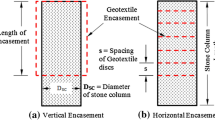Abstract
Stone columns in soft soil improve bearing capacity because they are stiffer than the material which they replace, and compacted stone columns produce shearing resistances which provide vertical support for overlying structures or embankments. Also stone columns accelerate the consolidation in the native surrounding soil and improve the load settlement characteristics of foundation. In this paper, the finite element method is utilized as a tool for carrying out analyses of stone column–soil systems under different conditions. A trial is made to improve the behaviour of stone column by encasing the stone column with geogrid as reinforcement material. The program CRISP-2D is used in the analysis of problems. The program allows prediction to be made of soil deformations considering Mohr-Coulomb failure criterion for elastic–plastic soil behaviour. A parametric study is carried out to investigate the behaviour of standard and encased floating stone columns in different conditions. Different parameters were studied to show their effect on the bearing improvement and settlement reduction of the stone column. These include the length to diameter ratio (L/d), shear strength of the surrounding soil and, the area replacement ratio (as) and others. It was found that the maximum effective length to diameter (L/d) ratio is between (7–8) for Cu, between (20–40) kPa and between (10–11) for Cu = 10 kPa for ordinary floating stone columns while the effective (L/d) ratio is between (7–8) for encased floating stone columns. The increase in the area replacement ratio increases the bearing improvement ratio for encased floating stone columns especially when the area replacement ratio is greater than (0.25). The geogrid encasement of stone column greatly decreases the lateral displacement compared with ordinary stone column.





























Similar content being viewed by others
References
Aboshi H, Ichimoto E, Enoki M, Harada K (1979) The composer—a method to improve characteristics of soft clays by inclusion of large diameter sand columns. In: Proceedings international conference on soil-reinforcement. Reinforced earth and other technique, Paris, pp 211–216
Baraksdale RD, Bachus RC (1983) Design and construction of stone columns, Federal Highway Administration Vol.1. School of Civil Engineering, Georgia Institutes of Technology, Atlanta. (www.fhwa.dot.gov)
Bowles JE (1996) Foundation analysis and design, 5th edn. McGraw-Hill, New York, p 1175
Kempfert H, Gebreselassi B (2006) Excavations and foundations in soft soils. Springer, Germany
Majeed QG (2008) Assessment of load capacity of reinforced stone column embedded in soft clay. M.Sc. thesis, Building and Construction Engineering Department, University of Technology, Baghdad, Iraq
Mitchell JK (1981) Soil improvement (State of the Art Report) General report session 12. In: Proceedings of 10th international conference on soil mechanics and foundation engineering. Stockholm. Vol. 4, pp 509–565
Tanimoto K (1973) Introduction of the sand compaction pile method as applied to stabilization of soft foundation grounds. Common Wealth Scientific Industrial Research Organization, Australia
Shenzhen Ktyu Insulation Co., Ltd. (www.geogrid.biz)
Author information
Authors and Affiliations
Corresponding author
Rights and permissions
About this article
Cite this article
Fattah, M.Y., Majeed, Q.G. Finite Element Analysis of Geogrid Encased Stone Columns. Geotech Geol Eng 30, 713–726 (2012). https://doi.org/10.1007/s10706-011-9488-8
Received:
Accepted:
Published:
Issue Date:
DOI: https://doi.org/10.1007/s10706-011-9488-8




